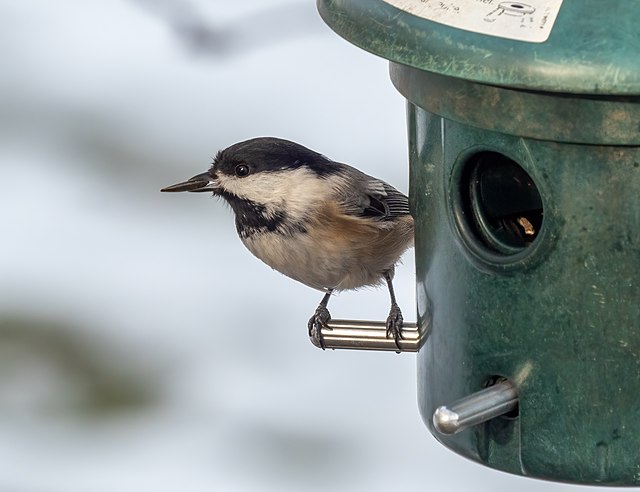February 2022 Gardening Advice

February is National Bird Feeding Month! Black-capped chickadee at bird feeder.
submitted by Jennifer Fairfield, Garden Mill and Manchester Community & School Gardens
With winter halfway over, it’s time to start really planning for our gardens. If you haven’t already, it’s time to go through your seeds to see what you have left over and what you will need for the upcoming season.
To Do Indoors This Month:
First things first – put together a plan for your gardens this year. If you are planning a vegetable garden, what do you want to grow? Do you have a garden already, and just need to decide what to plant where this year, or are you just starting out and need to figure out where to put your garden and how much space you will need for everything you want to plant? Planting flowers? You’ll need to know what kind of sun and soil the flowers you want to plant need (or better yet, what flowers you can plant in the sun and soil you have). If you need help in making decisions, there are so many apps out there now that can help. Some do a great job of giving you ideas by showing you lots of pictures of what others have done. Other apps provide more in-depth information about locating and plotting out the actual design of your garden. Some apps will even let you take pictures of your current landscape and see how certain plants will look in your yard. Spend some time now to decide what you want to do, so that when it’s time to do it, you are prepared to look for the seeds, plants, soils, fertilizers, tools, and structures you’ll need.
Did you keep a journal of your gardening last year? If so, go through your notes now so that you know what plants did well for you, what didn’t do so well, and what changes you thought you might want to make this year. Like planning, this will help you decide what you need to make your gardening successful this year. If you didn’t keep a journal last year, start one now for this year, and start writing down all the things you want to do! Whether you keep a digital journal or an “old fashioned” paper one, a garden journal can be incredibly helpful when you are making plans each season – mine helps me remember what the weather was like, and how my plants reacted to it; what kind of watering different plants needed under different conditions; which varieties of plants did better; and what I used that helped with disease and pest control.
As I mentioned, now is the time to go through seeds leftover from last year – many of them will still be perfectly fine for planting this year. Once you’ve figured out what you have, determine what you need and go get it. If you wait too long, you may not get the varieties you want – it looks like the issues we’ve all been experiencing with finding just about anything will also still be impacting the seed industry this year, so the early bird will get the seeds!
If you are going to start plants indoors this year, make sure you have everything you need – seed starting mix, pots, working lights, heating mats, etc.
March is generally when the majority of vegetables grown around here get started indoors, but you should start rosemary, onions, and leeks in early February and celery in mid-February.
Starting perennial flowers indoors this month also gives them more time to get to transplanting size and makes them more likely to bloom the first year. It’s also a great way to save money, as seeds and soil generally cost a lot less than perennial plants! February is also the time to start some annual flowers indoors, if you’re growing your own. Pansies and geraniums get started early this month, while impatiens, lobelia, and stock should be started mid-month.
Be sure to clean out any previously used pots you want to use for repotting of house plants or for outdoor container gardening. Disinfecting your pots before using them again ensures that they are not harboring any harmful bacteria. Do this task now so your pots will be ready to use when you’re ready for them. Use a 1 to 9 ratio of bleach to water and a wire brush to be sure to get all the leftover dirt, and then thoroughly rinse the pots to get rid of the bleach.
Clean and sharpen your tools, if you didn’t in the fall, so that they are ready to get to work when you are.
To Do Outdoors This Month:
Now, and really any time this month, is the best time to prune most trees and shrubs. What makes this the best time? It’s the fact that they are dormant, and pruning trees and shrubs while they are dormant means that there you aren’t likely to introduce disease to your plants via the open wounds that are left when you prune. Open, seeping wounds attract insects that carry disease from infected plants when you prune during the time that insects are around. Since plants are dormant now, they won’t be seeping, and since it’s too cold outside for pretty much all insects, you lessen your chances of infection to your trees and shrubs by pruning now. Oak trees should only ever be pruned at this time of year, because they are extremely susceptible to oak wilt disease if pruned in warmer months.
Some ornamental trees and shrubs shouldn’t be pruned at this time of year, because doing so will reduce flowering this spring. A general rule of thumb is to prune trees and shrubs that bloom after the end of June during the winter (now), and those that bloom before the end of June once they have finished blooming.
If you sometimes have deer or rabbit damage, you might want to treat your vulnerable plants with a repellant, or re-treat if you treated earlier. Food options are slim for these guys at this time of year, so they will be looking for easy pickings, and your landscaping plants can look very good right about now.
For the Birds:
February is National Bird Feeding Month, for a good reason! By this point in winter, natural sources of food are getting scarce, so keeping feeders full can be critical to your birds' survival. It’s especially important after a big snowfall, since their food sources get covered by the snow. I try to make sure that my feeders are full leading up to a big snow event so that the birds have the chance to fill up before the snow starts flying. Then, once the snow stops, I will go out and clean the snow off the feeders so the birds have access to the food – searching for food uses up a lot of energy!
Keeping bird baths full and thawed is also important now. A heated birdbath or a deicer in your birdbath provides your birds access to a good supply of fresh drinking water. If you’ve read anything online about heated birdbaths being bad for birds because the water sticks to their feathers and then can freeze once they are out of the bath, please don’t let it stop you from helping out your feathered friends. Birds are pretty smart, and won’t generally dunk their whole bodies into water when the air temperature is dangerously low. Adding rocks to your birdbath, or giving them other perches, will allow them to get water without getting wet.
If you’re looking for something fun for the whole family, that you can do in your own backyard or in a nearby park, I highly recommend the Great Backyard Bird Count. This year’s count takes place February 18th through the 21st, and is a fun way to help scientists understand global bird populations. Find out all about it, including how to sign up for an informational webinar being held on February 16 at www.birdcount.org/participate/. If you want to get out of the house to do your counting, there are great trails in Waterloo State Recreation Area and Watkins Lake State Park and County Preserve that might give you the opportunity to see birds you might not find at home. Of course, if you do it at home, you can stay in your nice, warm house while counting! The great thing about bird watching is that it’s easy for everyone at every level of ability.








You must be logged in to post a comment Login